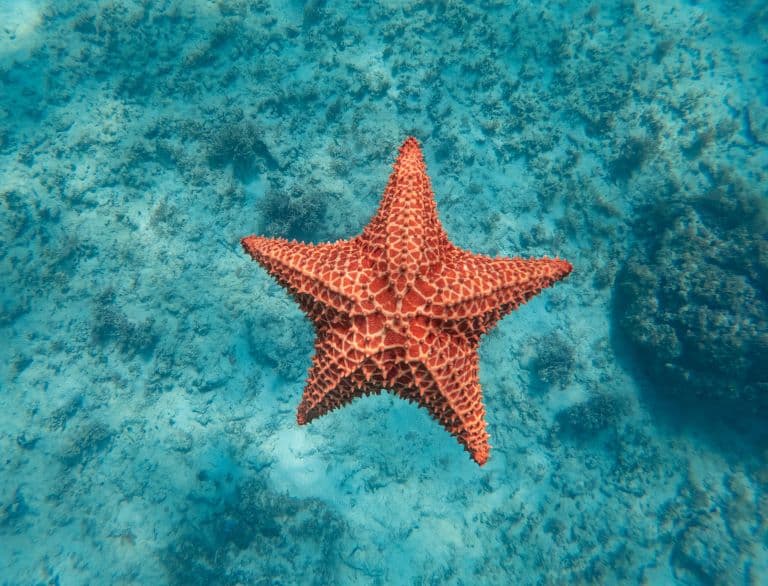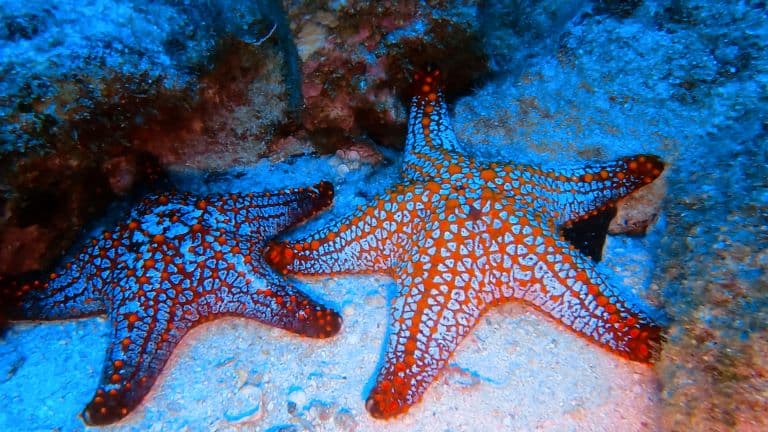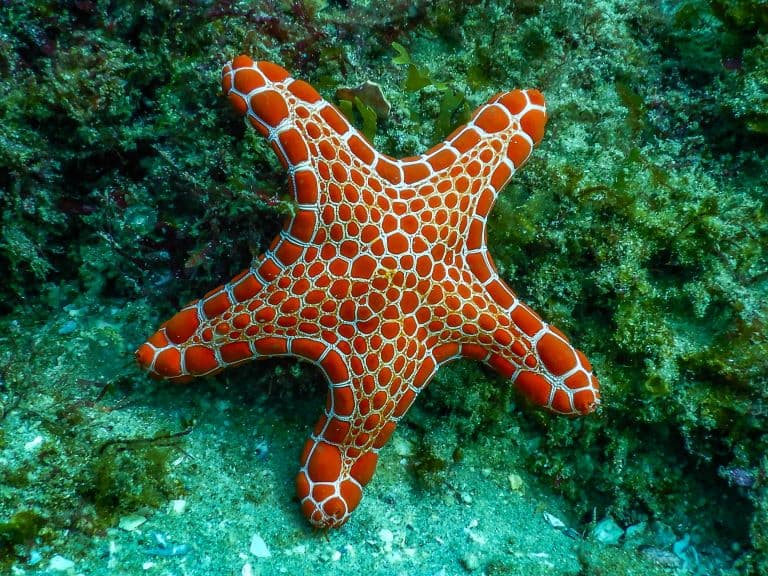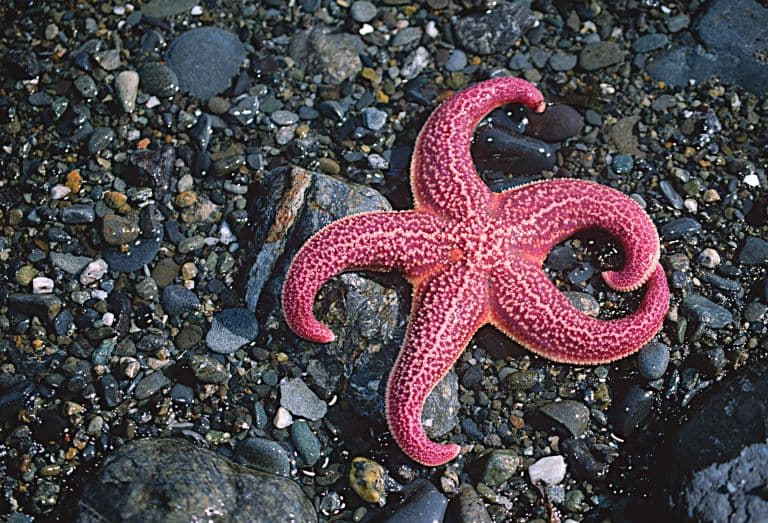Starfish Profile
The Echinoderm lineage is one of the most fascinating in the ocean. Half a billion years old, it contains some of the strangest animals in the world. One line within this ancient phylum contains the radially symmetrical, hydraulic-armed sticky-footed class known as Asteroidea: the starfish.

Starfish Facts Overview
| Habitat: | Marine, all depths |
| Location: | Worldwide |
| Lifespan: | 37+ years |
| Size: | Up to 134 cm (53 in) across |
| Weight: | 5 kg + (11 lb) in largest species |
| Colour: | All colours and shades |
| Diet: | Varied, mostly shellfish |
| Predators: | Crabs, lobsters, fish, other starfish, sea anemones, gulls. |
| Top Speed: | 15 cm (6 in) per minute |
| No. of Species: | Around 2000 |
| Conservation Status: | Ranging from Least Concern to Critically Endangered (IUCN) |
Starfish are true survivors. Taking advantage of natural disasters to exploit new niches, they are now found anywhere with marine waters – from hot to cold, shallow to deep, and everything in between. Starfish thrive by being brave enough to be weird.
Interesting Starfish Facts
1. They’re Ancient
Starfish are a class of one of the most alien lifeforms on the planet. The Echinoderm phylum dates back to the Cambrian period, possibly as far back as half a billion years.
In many places, the limestone bedrock that entire cities are built on was formed by the countless trillions of fossilised Echinoderm skeletons that built up over millions of years.
Starfish make up one class of echinoderm called Asteroidea. This class was once dominated by the Blastoids (now extinct) and Crinoids (feather stars) that suffered significantly in the two subsequent extinction events.
In their place, the surviving starfish exploded and rapidly radiated out into most of the newly available niches.
Today they and the feather stars share the phylum with sea urchins, sand dollars, brittle stars, basket stars, and the quite different sea cucumbers. But starfish are still one of the most diverse classes, second only to the thousands of species of brittle stars.

2. They’re everywhere
Being so diverse and successful, starfish have explored and conquered almost every niche in the marine world.
They commonly have five arms but can have up to 50. They come in all colours and reproduce sexually and asexually. Some even give birth to live young.
There are starfish in rock pools and starfish in the deepest parts of the ocean. They are found in tropical coral reefs and frigid Antarctic waters.
About the only thing holding them back is their inability to regulate the salinity of their bodies, which means that the best they can do is slightly brackish water – there are no freshwater starfish, and no terrestrial ones, which, judging from how dominant they are is probably good news for us landlubbers.
They also have a range of sizes, ranging from the tiny, 1cm wide Parvulastra parvivipara, to some seriously impressive giants.
3.They can be enormous
Sunflower sea stars are the heaviest known starfish, growing up to a metre across, having up to 24 arms, and weighing around 5 kg.
This is impressive, but the deep water species Midgardia xandaros grows to 38cm larger than this, and is the largest known starfish, with 12 arms that are used to filter organic matter from the water.
This is a nice passive way to feed, but starfish are better known as formidable predators. 1

4. They can be venomous
Being so widespread and diverse, there are quite a lot of things that feed on starfish. Many are entirely defenceless, but some come with their own weaponry against attack.
They can release slime, as seen in the well-named slime star, and the sand-sifting starfish even packs tetrodotoxin, the infamous puffer fish poison.
Crown of thorns starfish contain several saponins; secondary metabolites of their diets that act as a toxic defence. Covered in thorns, these can seep into a wound inflicted by anything that steps on or tries to mouth the starfish and can cause tremendous pain, nausea and lots of bleeding.
But these starfish, like so many other species, are far more significant as predators than as prey. This species in particular feeds on corals, sweeping over the sedentary Cniderians slowly like a devastating Roomba.
Others use their muscular arms to pry open clams and other bivalve molluscs. Despite being slow-moving, starfish are formidable predators and can cause significant damage to ecosystems where they are given free rein. 2
5. They can be dangerous
We often see the destruction that stems from introducing a predator to an ecosystem that wasn’t evolved to handle it: domestic cats or wild rats wreak havoc on island ecosystems, eating the eggs of ground-nesting birds who had never evolved to lay their eggs in the tree canopy.
But the same mechanism occurs with native predators when you remove their limiting factors. Limiting factors are nature’s way of maintaining the balance, and they can come in the form of larger predators, seasonal changes, nutrient availability – essentially anything that holds an organism back.
The crown of thorns starfish was once limited by the nutrients available in the water and by larger predators. While adults feed on corals, their larvae eat algae.
This is a vulnerable time for a baby starfish, and in times of poor nutrient supply, fewer algae grow and fewer larvae survive. Those that do have to also avoid predation.
But both of those factors have been more or less removed around the Great Barrier Reef in Australia. The rampant overfishing of our oceans has led to a dramatic decline in marine predators, and agricultural runoff from farming has flushed the waters with nutrients.
The result is a catastrophic bloom in starfish and they’re destroying the reef.
So, while this is a native predator in its natural habitat, it often acts as an invasive one, demonstrating the interconnectedness of all organisms in an ecosystem and showing us why biodiversity is important all the way up the food chain. 3 4
6. They’re weird
If this wasn’t obvious already, there may be more chances to get the point across.
Starfish have multi-chambered digestive systems that extend into their arms, and some can push one of these chambers out of the mouth, wrapping it around their prey and digesting it a bit before bringing it into the body.
This allows some species to hunt prey larger than their mouths and certainly makes them all the more creepy.
But there’s another thing starfish can do that really doesn’t belong anywhere in our familiarity index as vertebrates.

7. They have extreme autonomy!
We often see certain species with autonomy – the ability to detach a limb in self-defence. Geckos are known for this, and while it’s creepy to see a disembodied tail wriggling about energetically, it’s not all that unusual.
What we don’t see nearly as much is that tail then growing arms and legs and a head and wandering off to live its life as another gecko. But that’s exactly what happens in some species of starfish.
The common comet star, Linckia guildingi, is widespread around the Pacific, Indian, Atlantic and Caribbean seas, and probably in part because it can just bud off and make more of itself.
One or more of its arms can pop off (fine), and then the body with an arm missing will grow a new one (also fine). But the arm itself doesn’t die – instead, the detached arm, known as a comet, moves about independently and gradually replaces its missing body and continues life as another starfish.
Echinoderms are quite well known for blurring the lines for what is acceptable, and this is a great example, but if you’re still not convinced, look at what their children are doing.
8. Even their babies can reproduce
Free-living larval forms of starfish are far too young to know what sex is, but that doesn’t mean they can’t reproduce.
Until recently, sea stars and brittle stars are the only organisms in which asexual reproduction within larval forms has been witnessed. New research shows that this is very much an Echinoderm thing, and spontaneous cloning of larvae has now been seen in sea cucumbers, sea urchins and sand dollars.
It’s suggested that this ability might be an ancient one, and could be locked somewhere in the genes for all deuterostomes – a group of animals that includes vertebrates. 5
Starfish Fact-File Summary
Scientific Classification
| Kingdom: | Animalia |
| Phylum: | Echinodermata |
| Class: | Asteroidea |
| Order: | 7 Orders |
| Family: | 37 families |
Fact Sources & References
- “Largest starfish”, Guiness World Records.
- “SEA STAR DEFENSE! How do starfish protect themselves??”, The Echinoblog.
- (2018), “Crown of thorns starfish larval flow”, eAtlas.
- James Woodford (2024), “Culling predatory starfish conserves coral on the Great Barrier Reef”, New Science.
- Alexandra A. Eaves (2003), “Widespread cloning in echinoderm larvae”, nature.
